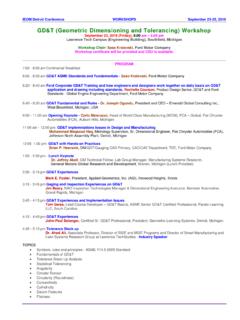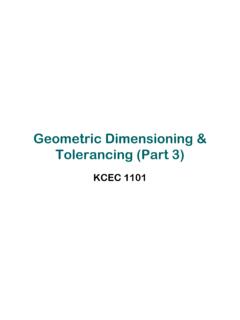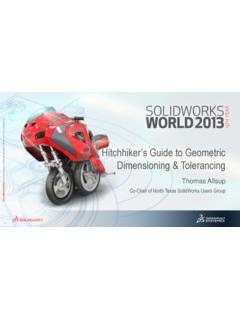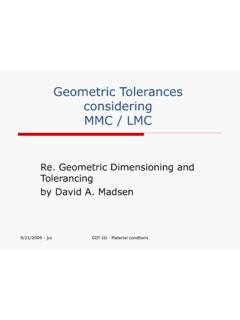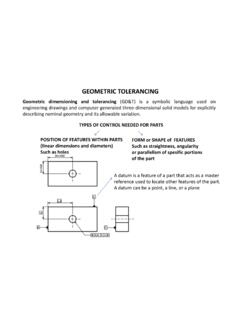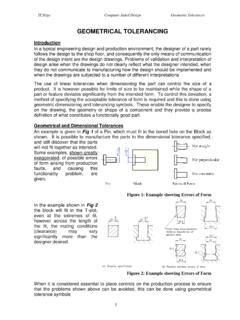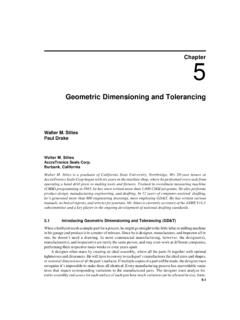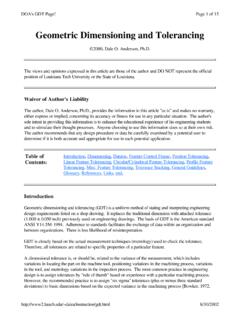Transcription of Geometric Dimensioning & Tolerancing (GD&T) …
1 PDHonline Course M347 (5 PDH) Geometric Dimensioning & Tolerancing (GD&T) and design For Six sigma (DFSS)2012 Instructor: Robert P. Jackson, PEPDH Online | PDH Center5272 Meadow Estates DriveFairfax, VA 22030-6658 Phone & Fax: Approved Continuing Education PDH Course M247 Robert P. Jackson Page 2of 39 TABLE OF CONTENTS PART I INTRODUCTION 5 design FOR SIX sigma (DFSS) 5 DFSS TOOLS 7 IDENTIFY 0R DEFINE 8 IMPORTANCE OF SIX sigma GOALS 9 MEASURE AND ANALZSE 11 design 12 APPLICATION SOFTWARE 12 design TO OPTIMIZE 13 VALIDATE 14 PART II Geometric Dimensioning AND Tolerancing (GD&T) 14 GD&T STANDARDS 15 BENEFITS 16 RULES 17 SYMBOLS 18 MODIFYING TOLERANCES SYMBOLS 19 GD&T EXAMPLES 19 FEATURE CONTROL FRAME 23 READING BASIC SYMBOLS 25 PART III DFSS & GD&T 28 TOLERANCE ALLOCATION 28 STATISTICAL ALLOCATION 30 EXAMPLES 32 PDH Course M247 Robert P.
2 Jackson Page 3of 39 LIST OF FIGURES Figure 1 Focus for Six sigma (DFSS) 7 Figure 2 Reliability Goal Setting 9 Figure 3 Process Capability Between 3 sigma and 6 sigma 10 Figure 4 DFSS Process 14 Figure 5 Tolerance Classes 19 Figure 6 Spline Assembly 20 Figure 7 Handle Using GD&T 20 Figure 8 Linear Dimensioning 21 Figure 9 Collar (GD&T) 22 Figure 10 Collar in English Only 23 Figure 11 Feature Control Frame 23 Figure 12 Flatness, Runout, Perpendicularity 26 Figure 13 MMC, LMC 26 Figure 14 Basic Dimension 27 Figure 15 Steps for Evaluating Gap Allocation 31 Figure 16 GE Lower Drawer 32 Figure 17 Loop Diagram 33 Figure 18 Motor Assembly 36 Figure 19 Refrigerator Door Trim 36 Figure 20 Refrigerator Door Trim Enlargement 37 LIST OF TABLES Table 1 Differences Between Six sigma and DFSS 6 Table 2 Six sigma vs DPMO & RTY 7 Table 3 DFSS Tools 8 Table 4 GD&T Characteristics 24 Table 5 Modifying Tolerance Symbols 25 Table 6 Standard Deviation vs Process 29 Table 7 Standard Deviation vs Process 29 PDH Course M247 Robert P.
3 Jackson Page 4of 39 Table 8 Tolerance Allocation Spreadsheet 30 Table 9 Dimensions and Mean Values 32 CONCLUSIONS: 38 REFERENCES: PDH Course M247 Robert P. Jackson Page 5of 39 Geometric Dimensioning & Tolerancing (GD&T) and design For Six sigma (DFSS) Robert P. Jackson, INTRODUCTION: This course is basically intended to address two distinct, but related, areas of engineering design : 1.) design FOR SIX sigma (DFSS) and 2.) Geometric Dimensioning AND Tolerancing (GD&T). Both concepts have been viable approaches to design and detailing for some years and both are extremely valuable and useful tools for the practicing engineer.
4 DFSS is a statistical method of design that can serve as a predictive tool to greatly improve quality control, if used properly and consistently. GD&T is a well accepted methodology of detailing the characteristics, dimensions and tolerances of a component or assembly of components. The GD&T methodology is prescribed by ASME / ANSI Standards Y 1994 and 2009. This course uses the tenants of DFSS AND GD&T to fully define a mechanical component, or assembly of components, so that no more than defects per one million parts will result when in use. DFSS and GD&T are usually taught as separate subjects but certainly complement each other as far as design tools. It is much more difficult to achieve six sigma (6 ) results without using the GD&T approach. By using standard linear Dimensioning instead of GD&T, huge errors can be made that leave room for doubt when designing tools and dies for fabrication.
5 This will become apparent as we address GD&T. For this reason, I am structuring the course to include, and integrate, both methodologies. I would like to state that the treatment of DFSS and GD&T will be somewhat general and not in depth as far as mathematical modeling, which sometimes accompanies courses of this nature. There are excellent texts available on both subjects but none that I have found integrating both disciplines. The combination of these two is definitely a logical presentation for blue collar, goal oriented, working engineers and engineering managers. The course is divided into four distinct divisions; 1.) DFSS Survey, 2.) GD&T Survey, 3.) Problem solving that shows how DFSS and GD&T interact and compliment each other AND 4.) Teachable QUIZ. Please note that I have chosen to construct the Quiz at the end of the course to be a learning experience. Several of the questions have descriptive information important to understanding the basic tenants of Six sigma and GD&T.
6 This descriptive information may not be in the body of the text itself. I ho pe to achieve an interest that will provide impetus for engineers and engineering managers to adopt both disciplines for their companies. I would also state that by using DFSS, GD&T AND the tenants of Reliability Engineering and Reliability Testing, a product can be designed and manufactured to satisfy the most critical end user, for either consumer or commercial products. PART I design FOR SIX sigma (DFSS): DFSS is the application of Six sigma principles to the design of components, subassemblies, completed products and their manufacturing and support processes. Six sigma , by definition, focuses on the production phase of a product. DFSS focuses on the research, design and development phase of a project and is truly a design tool that can and should be used by the design engineer to meet consumer expectations and demands.
7 The goal of DFSS is to implement the Six sigma methodologies as early in the product or service life cycle as possible, thereby guaranteeing the maximum return on investment (ROI). The methods used to insure rigor in both processes are somewhat different. Six sigma uses the DMAIC approach (Define, Measure, Analyze, Improve, Control). DFSS uses DMADV (Define, Measure, Analyze, design and Verify). Please note that DFSS strives to meet the same goals as Six sigma , that being no more than defects per million. In this respect, the end results are the same. The table below will give a very brief description of the differences between the two technologies. PDH Course M247 Robert P. Jackson Page 6of 39 DIFFERENCES BETWEEN SIX sigma AND DFSS SIX sigma DFSS DMAIC: Define, Measure, Analyze, Improve, Control DMADV: Define, Measure, Analyze, design , Validate DMADOV: Define, Measure, Analyze, design , Optimize and Validate Looks at existing processes and fixes problems.
8 Focuses on the up front design of the product and processes. More Reactive More proactive. Dollar benefits obtained from 6 can be quantified quickly. Benefits are more difficult to quantify and tend to be more long term. It can take six to twelve months after launch of the new product before you will obtain proper accounting on the impact. Product performance accomplished by build and test. Product performance modeled and simulated. Performance and producibility problems fixed after Designed for robust performance and producibility. Product in use. Quality tested Quality designed into the product. Table 1: Differences Between 6 & DFSS With DFSS you are designing quality into the component or product from the very start and hopefully eliminating waste by minimizing manufacturing variation before it happens. This approach allows for correcting problems up front and can significantly reduce the costs of redesign and testing.
9 It is also a great way to meet customer demands by establishing measurable goals. DFSS attempts to predict how the designs under consideration will behave and how to correct for manufacturing variation prior to the first production run. A gr aphical representation of the difference between DFSS and Six sigma may be seen as follows, relative to product costs. PDH Course M247 Robert P. Jackson Page 7of 39 Figure 1 Focus for DFSS vs Six sigma [ 3 ] Again, you can see that we want to implement DFSS at the research, design and development stages and early enough in the project so that we may introduce the component or subassembly with minimal manufacturing variation. This is the point where costs are at their lowest and changes are doable in considerably less time and with considerably less expenditure of capital or human resources.
10 DFSS TOOLS: In looking at the tools used with DFSS, the following, Table 3, represents the entire process, broken down by major action items. Please keep in mind that we pick and choose the best approach to Identify, design , Optimize and Validate. All steps along the way may not be needed and would represent considerable duplication of effort. WE WISH TO PRODUCE A MAUNFACTURED PRODUCT THAT WILL EXHIBIT NO MORE THAN DEFECTS PER MILLION OPPORTUNITIES AND WITH THE MAXIMUM ROLLED THORUGHPUT YIELD . The table below will demonstrate our objectives. CAPABILITY DEFECTS PER MILLION OPPORTUNITIES ROLLED THROUGHPUT YEILD 2 308,537 3 66,807 % 4 6,210 % 5 233 % 6 TABLE 2 SIX sigma VS DPMO AND RTY PDH Course M247 Robert P.










